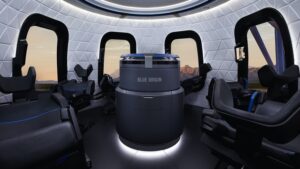The announcement took place 60 years to the day after the vehicle’s namesake, Alan Shepard, became the first American space on the suborbital Mercury 3 launch. The scheduled date of the flight is the 52nd anniversary of the Apollo 11 landing.
The company hinted during its most recent test flight of the vehicle April 14 that it was ready to start flying people on the vehicle. The company used the flight to test procedures for future crew flights, including having company personnel, playing the role of customers, boarding the vehicle during prelaunch preparations, and also practicing exiting the vehicle after landing.
“We have flown this vehicle 15 times and, after the last flight, we said, ‘It’s time. Let’s put people on board,’” said Ariane Cornell, director of astronaut sales at Blue Origin, in a call with reporters.
The company did not disclose who would fly on the vehicle, capable of carrying six people, beyond that it will make one seat available to the public via an auction. The company will accept sealed bids through May 19, then go into an unsealed bidding phase, concluding in a live auction June 12. Blue Origin said the proceeds of the auction will go to an affiliated nonprofit organization, the Club for the Future, that supports STEM education activities.
When Blue Origin announced April 29 that it would disclose its plans for selling the first seat on New Shepard, many expected it would formally unveil long-awaited plans to start selling tickets. The company has said little about its ticket sales strategy, including how much they would cost.
Cornell declined to discuss how the company would sell tickets beyond this initial auction. “We don’t have details on the prices for future seats, and we will announce the details of how those future seats will be sold in the future, after this auction.” She added the company will take notes of the “most active bidders” in that auction for follow-up on future ticket sales.
She also said that, after the July 20 flight, “we will have a couple more crewed flights before the end of the year.”
While the company didn’t disclose details on ticket sales, the company is sharing more information on the spaceflight experience. Cornell said that those who fly on New Shepard will arrive at the company’s West Texas site four days before launch and undergo three days of training. That will include working in a mockup of the New Shepard crew capsule learning procedures for getting in and out of the vehicle as well as emergency protocols.
Those who fly New Shepard have to meet a number of physical and other conditions, according to a terms and conditions document posted on the company’s website. That includes being at least 18 years old, weighing between 50 and 101 kilograms, being between 152 to 193 centimeters tall, and able to withstand 3g’s of acceleration during launch and 5.5g’s “for a few seconds” during reentry.
Blue Origin didn’t disclose how many people signaled an interest in flying on New Shepard by signing up on its website in the last week to find out how they could buy tickets. “I can say that the website has gotten a workout in the last week,” Cornell said. “Obviously, we hope that is a good precursor to excitement and participation in the auction on June 12.”
Loizos Heracleous, professor of strategy at the Warwick Business School, noted that there are about six million people worldwide with a net worth of at least $5 million, and thus likely in the addressable market for a flight like this.
“For some it will be about bragging rights, for others it will be an experience of a lifetime,” he said in a statement about why people would be willing to pay a premium to fly on a suborbital vehicle. “In strict financial terms it might not seem a wise decision, but if it’s a small part of their disposable income or net worth, they might want to do it.”



